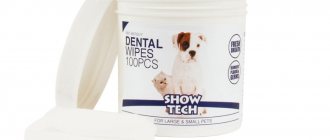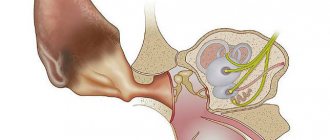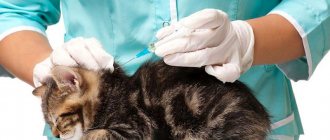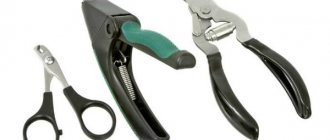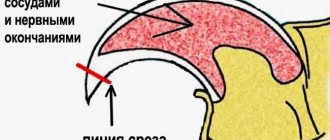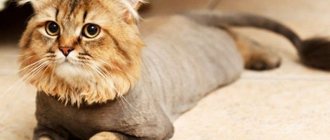By bringing a small fluffy kitten into our home, we take responsibility for its health. In addition to proper feeding, vaccinations, and grooming, ear cleaning should become a regular procedure. This is necessary in order to prevent ear diseases, which cause suffering in pets and take a long time to treat. Questions about how to clean a kitten’s ears, whether it is necessary to do this if the ear is clean, arise often. It all depends on the pet’s lifestyle, the breed, and even the size of the ears.
Signs you need cleaning
You can understand that your pet needs ear cleaning after an examination. To do this, the ear is carefully turned inside out and examined.
It should be borne in mind that the cat may not like this, so you need to accustom him to the procedure from a young age.
If there is a lot of dirt in your ears, then you just need to clean them. But in some cases it is better not to self-medicate, but to immediately contact a veterinarian:
- Black plaque. It may indicate infection with ear mites, and may also be a sign of otitis media or other serious diseases. If left untreated, there is a high risk of deafness. After diagnosis, the doctor will prescribe ear drops depending on the form. Treatment must be carried out every day.
- Atypical formations. Consultation is necessary to determine the diagnosis. Most often, the course of treatment lasts from 15 to 20 days, then a re-examination by a specialist is required.
Other indications for ear cleaning:
- Large amount of sulfur. Ear cleaning is carried out as it accumulates, the frequency depends on the individual characteristics of the cat and breed.
- Exhibition. When attending various competitions, the cat must be clean, as the judges pay attention to such moments.
- Lack of wool. There is a risk of proliferation of pathogenic microflora, since there is no natural barrier protecting against dirt. Typical for hairless cats.
- After swimming. Remove residual moisture from the ear, this helps prevent the development of otitis media.
Features of caring for fold-eared cats
Fold cat ears are cleaned in the same way as any other pet. The nuance is that such breeds are not able to wash the “locators” themselves due to the unusual structure of the auricle. More frequent inspection and close attention will be required.
Proceed as usual. To begin, turn the ear outward (as it should be when properly cleaning a cat’s ears) and use a flashlight to illuminate the ear canal. Be careful - cats' cartilage is very delicate. If you notice plaque and dirt, remove it as you would a regular cat.
After the procedure, you will have to thoroughly dry the folded ear, because excess moisture can lead to diaper rash and the rapid formation of diseases.
What to use when cleaning
All items for cleaning ears must be prepared in advance:
- Cotton buds. Factory products with limiters are used.
- Cotton pads.
- Special lotions. Can be found in veterinary pharmacies (Beaphar, Excel Ear Cleansing). In the absence of special solutions, they can be washed with Chlorhexidine, Miramistin, and hydrogen peroxide. Oil is often used to remove wax plugs, but it is better not to use this remedy.
- Flashlight. For a better overview, you can use a head-mounted one so that both hands are free.
- Towel or sheet. Not all cats tolerate such procedures calmly; they begin to break free and are not allowed to be cleaned; they are usually restrained additionally.
It is important to choose treatment products carefully; for example, when using Frontline, which contains alcohol, cats often drool.
Examination of the animal's ears
This procedure should be performed from an early age, which will allow the pet to get used to it and will not cause a negative reaction in him. When examining, pay attention to the presence of the following factors:
- sulfur and pollution;
- bloody spots;
- unpleasant odor;
- tumor formations;
- hyperemia and inflammation;
- scratches and scratches.
In order to properly carry out the examination, you need to carefully bend the ear, slightly turning it inside out. The inside must be clean. The passage is pale pink. If there is a large accumulation of sulfur, the passage should be cleaned. But, if in addition to it, you saw something else, contact your veterinarian to be on the safe side.
Before performing the manipulation, it is advisable to play with your pet so that he does not perceive it as something bad, after which you can give him a treat.
Removing earwax with a cotton swab
How to properly clean a cat's ears
Processing must be consistent and correct:
- In order not to injure the pet or get scratches, it is fixed. To do this, use a sheet or blanket. They wrap the limbs and body of the animal, except for the head.
- Then carefully turn the ears out and inspect for dirt. If they are absent, the cat is released.
- If small dirty areas are found, wipe them with a dry cotton pad.
- If there is a lot of plaque, the ears are treated with a special lotion. Move from the inside out to prevent dirt from remaining in the ear canal. If necessary, dirty cotton swabs are replaced with clean ones until the entire surface is cleaned.
- Then, using cotton swabs soaked in a special product, carefully treat the bends and folds. It is not recommended to insert them deeply, as this can damage the eardrum.
- If wax plugs are detected, special ear drops (Otifri) are used to help loosen them. When instilling, massage the animal’s ear so that the product gets into the passage and is evenly distributed.
- After the procedure is completed, the cat is released and praised. Give a treat that improves the pet's mood.
Preparatory procedures
Before cleaning your cat's ears, you need to prepare a cleaning solution and other necessary products. You should not immediately wash and treat your pet’s ears. First, it is recommended that owners pay attention to the cat, calm it down and prepare it. If hygienic manipulation is carried out for the first time, it can cause discomfort and possibly pain to the cat. It is possible to let the animal sniff the tools being used so that the pet does not feel threatened when using unfamiliar devices.
Mr. Cat warns: watch out for ear mites
The ear mite is a microscopic arthropod parasite that lives in the ear canal, whose diet includes epithelial cells. Identified by a dark brown coating on the inner surface of the ear. And also for the following reasons:
- The cat behaves differently than usual, is worried, often shakes its head, scratches its ears until it bleeds, and rubs against the furniture.
- An unpleasant odor emanates from the animal’s ears and dark crusts form.
- The cat's hearing is impaired and it does not immediately respond to calls.
If dark spots are found throughout the inner surface, you should treat them with lotion with silver ions (Cliny, Veda), which will remove plaque. Then drip with a special product (Tsipam, Decor-2, Otidez, Bars). Carry out the procedure according to the instructions for the drug until complete cure (2-3 weeks).
Why does dirt appear in a cat's ears?
The auricle has a complex shape. Sulfur secretions, which are present normally, perform a protective function for the middle ear. But if they are present in excess quantities, they can become a favorable environment for the development of pathogenic microorganisms.
Dust particles, small hairs, dirt constantly get into the ears, and flakes of dying skin also accumulate. In response to this, a protective substance is produced - sulfur, which creates an obstacle to the penetration of contaminants.
Without proper care, wax plugs may form or inflammation may develop, which in special cases will lead to complete or partial hearing loss, as well as changes in the functioning of the vestibular apparatus. And hearing for them is the most important factor, because the sensitivity of a pet’s ear is several times higher than that of a human.
Required accessories
The most common ear problems
In addition to ear mites, pets often encounter other diseases that require treatment, and if left untreated, lead to serious complications.
Otitis
Otitis is a disease in which the ear canal is affected by bacteria or yeast.
It is characterized by the following symptoms:
- purulent discharge with an unpleasant odor can be observed from the ears;
- the cat shakes its head intensely;
- the mucous membranes of the ears turn red and swell;
- The pet constantly scratches itself and meows.
Therapy is prescribed by a veterinarian after examination. Self-medication can cause complications and lead to inflammation or deafness.
Hematomas
Formed due to ruptures of blood vessels.
Reasons: The cat often shakes its head or scratches its ears. They can be identified by small burgundy spots between the auricle and the skin.
Solar dermatitis
Albinos, hairless cats and pets with white ears are susceptible to this disease. Solar dermatitis can be identified by redness of the skin and hair loss at the edges.
If you don't take action, the itching may cause your cat or cat to scratch its ears and cause an infection. There is a risk of tumors.
Squamous cell carcinoma
This neoplasm is a consequence of solar dermatitis. It affects various areas of the skin, but most often develops on cat ears. The main symptoms include red spots, lumps and hair loss. There may be ulcers that do not heal for a long time.
Frostbite
Due to hypothermia, there is a risk that the ear tissue will collapse. It can be identified by changes in skin color, first it loses color and then turns red. At the last stage it turns black and begins to peel off.
Restless behavior is caused by otitis media, ear mites, fleas or allergies. Only an established cause will help solve the problem.
To make an accurate diagnosis and correctly prescribed treatment, it is necessary to consult a specialist.
Frequency of manipulation
For a healthy animal, it is enough to carry out such manipulations once every 14 days.
Ears need to be cleaned when they become dirty or due to certain diseases. If there are no pathologies, then you can wash the cat’s ears once every 2 weeks. There are some cat breeds that are prone to increased accumulation of wax, so their ears need to be inspected and cleaned more often. Some individuals require hygienic manipulation once every 2-3 days.
Step-by-step instruction
If your pet strongly resists, categorically refuses to undergo cleaning, breaking free from your hands, then it is better to secure it with a towel.
Stages of implementation:
- Warm the lotion in your hands before starting so that the cold drops do not cause discomfort.
- Shake the bottle vigorously for 10-15 seconds.
- Open the bottle and drop 2-3 drops of the product into the passage, tilting the animal's head to the side.
- Using circular movements, massage the base of the ear to distribute the liquid over the entire surface.
- Release your head so Fluffy can shake it. This will allow the dirt to come off better.
- Soak a cotton pad or swab in lotion and wipe the inside surface with it, paying attention to each fold.
- If the ear is completely cleared, then proceed to the second one.
Of course, it is better to entrust the entire process to a veterinarian, but this is not always possible. If there is a lot of dirt, then home cleaning will not be enough.
Cleaning with a cotton pad
Causes of pancreatic diseases
Predisposing factors that potentially negatively affect the health of the pancreas and can provoke the development of diseases include:
- poor nutrition, poor diet, predominance of fatty and fried foods;
- alcohol abuse;
- obesity;
- smoking;
- hereditary predisposition to the development of pancreatic diseases;
- pathologies of the liver and biliary tract;
- diabetes;
- diseases of the gastrointestinal tract, including gastritis;
- past intoxication;
- congenital or acquired anomalies of the pancreatic ducts;
- violation of microcirculation in the organ;
- disseminated intravascular coagulation syndrome.
The risk of developing pancreatic cancer increases in patients with chronic pancreatitis with frequent episodes of relapses.
When to contact a veterinarian
If during examination you find pus, crusts, or bumps, then you need to see a veterinarian, as this indicates the development of a specific disease.
In addition, you need to visit a veterinarian if you regularly do preventive cleaning, but do not observe the desired effect. Sulfur, impurities constantly accumulate, an unpleasant odor has appeared, during the procedure there are purulent traces on the cotton pad, or the cat is restless, shaking its head, or itching. These symptoms are a sign of a serious illness.
Ear cleaning at the vet
